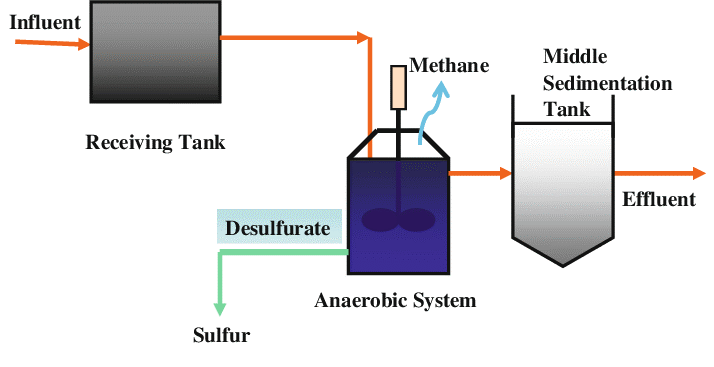The treatment method that involves microorganisms and organisms is called biological wastewater treatment. Biological wastewater treatment has two types: anaerobic wastewater treatment and aerobic wastewater treatment. Aerobic wastewater treatment uses aerobic microorganisms. Aerobic microorganisms need O2, therefore, it is necessary to add O2 to the septic tank. Anaerobic wastewater treatment uses anaerobic microorganisms. Therefore, the anaerobic treatment process doesn’t use O2. The main difference between aerobic and anaerobic treatment systems is that in aerobic treatment, the septic tank continuously supplies O2 and in anaerobic wastewater treatment it prevents gaseous O2 to enter the system.
What is anaerobic wastewater treatment?
Anaerobic wastewater treatment is a method where microorganisms break down organic pollutants in the absence of oxygen. In a basic anaerobic treatment cycle, wastewater enters the bioreactor vessel. Bioreactors contain thick semi-solids called sludge, which are made up of microorganisms such as anaerobes. These anaerobic microorganisms or “anaerobic bacteria” digest biodegradable substances in the wastewater, which leads to biochemical oxygen demand (BOD), chemical oxygen demand (COD) and/or total floating body (TSS). Biogas products.
Anaerobic treatment is used to treat various industrial sewage from agriculture, the food and beverage industry, the dairy, paper and pulp industry, the textile and sludge industry, and municipal wastewater.
Anaerobic techniques are typically used for streams containing high levels of organic matter (measured as high BOD, COD, or TSS), usually prior to aerobic treatment. Anaerobic treatment is also used in special applications such as wastewater treatment with inorganic or chlorinated organics and is well suited for treating hot industrial wastewater.
Working of anaerobic wastewater treatment
Anaerobic wastewater treatment is a biological treatment that uses anaerobic microorganisms to break down and remove organic pollutants from wastewater. Anaerobic treatment systems come in many forms, but generally include some form of bioreactor or reservoir that can maintain the anoxic environment required to support the anaerobic digestion process.

Anaerobic treatment system consists of two stages, an acidification stage and a methanogenesis stage, both of which are in dynamic equilibrium. In the early stages of acid formation, anaerobic bacteria break down complex organic compounds into simpler short-chain volatile organic acids.
The second stage, known as methanogenesis, is the production of acetic acid, in which anaerobic bacteria synthesize organic acids to produce acetic acid, hydrogen and carbon dioxide, methanogenesis, and anaerobic microorganisms that act on these newly formed molecules. It consists of two steps: producing methane. Gas and carbon dioxide. These by-products can be recycled as fuel and the wastewater can be used for further treatment and/or emissions.
Depending on the application and system requirements, the anaerobic digestion system can be designed as a single or multi-stage device. That is, it can be equipped with separate acidification tanks and bioreactor devices.
Advantages of Anaerobic Treatment Process
- The organic pollutants found are converted into biogas, which have a high energy value. This enables, for example, the complete or partial recovery of the energy required to operate a water treatment plant.
- The sludge growth in anaerobic reactors is 4-5 times less than in aerobic systems. It is possible to work on an event. If not fed anaerobic sludge, it will overwinter, meaning it can extend the time without food without causing excessive sludge mortality. The system wakes up immediately after the restart.
